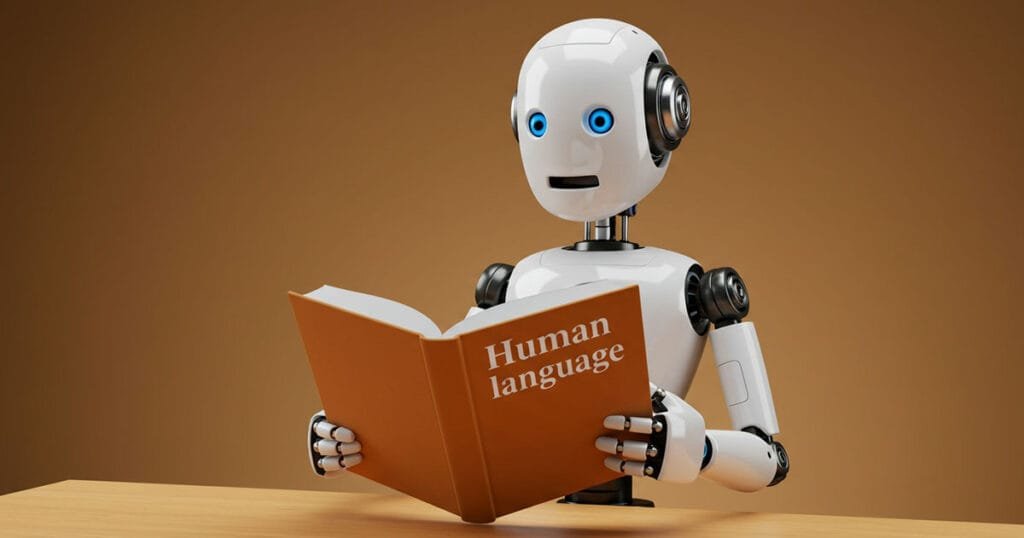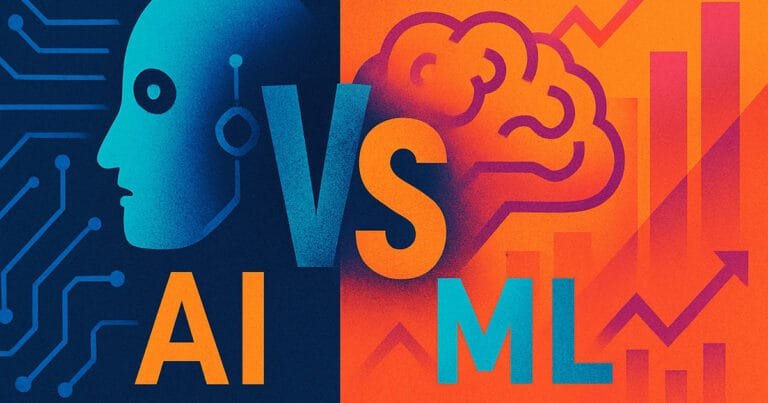Have you noticed how chatbots and virtual assistants seem to know exactly what you mean—at least most of the time? From asking Siri about the weather to solving customer service issues through website chat windows, these clever AI systems have become everyday tools in our digital lives. Natural language processing (NLP) is the technology that makes this possible, allowing machines to interpret and respond to human language in meaningful ways.
This isn’t just a minor technological advancement. We’re witnessing a fundamental shift towards language as the primary way we interact with computers. Major technology companies like Google, IBM, Amazon Web Services, Microsoft, and OpenAI have invested heavily in this area, recognising its growing importance.
But what makes these machines able to understand our messages and respond in helpful ways? The answer lies in natural language processing, the technology that helps computers make sense of human language.
The Rise of Talking Machines
Chatbots have quietly become part of our everyday routines. They help us book appointments, answer questions about products, suggest movies, and even offer health advice. This shift isn’t just about making things more convenient; it marks a major change in how we interact with technology.
Instead of learning special commands or clicking through menus, we can simply talk or type as we would to another person. Companies like Google, Microsoft, Amazon, and OpenAI have invested heavily in this technology, recognising that natural language is becoming the main way we communicate with computers.

What Is Natural Language Processing?
Natural language processing sits at the crossroads of computer science, artificial intelligence, and linguistics. It gives machines the ability to read, understand, and create human language.
While most of us think of NLP in terms of chatbots, its applications reach much further:
- Translation services that convert text between languages
- Tools that analyse social media posts to gauge public opinion
- Systems that summarise long documents into key points
- Email filters that catch spam
- Search engines that understand what you’re looking for
At its heart, NLP aims to make talking to computers feel natural and easy, eliminating the need to learn special commands or programming languages.
How Chatbots Process Your Words
When you type a message to a chatbot, it doesn’t instantly grasp your meaning the way a human would. Instead, it works through several steps to break down and understand your words.
Step 1: Cleaning Your Text
First, the chatbot needs to prepare your message for analysis:
- Tokenisation: Breaking your message into individual words or phrases. For example, “Where’s my order?” becomes [“Where”, “‘s”, “my”, “order”, “?”].
- Normalisation: Converting text to consistent forms, usually by making everything lowercase and removing punctuation.
- Stop Word Removal: Filtering out common words like “a”, “the”, and “is” that add little meaning.
- Word Reduction: Using techniques like stemming or lemmatization to reduce words to their base form. For instance, “running,” “runs,” and “ran” all become “run”.
Step 2: Understanding Structure and Meaning
Once your text is cleaned up, the chatbot moves to the more complex work of extracting meaning:
- Part-of-Speech Tagging: Identifying whether each word functions as a noun, verb, adjective, etc.
- Parsing: Analysing the grammatical structure of your sentence to see how words relate to each other.
- Named Entity Recognition: Spotting important pieces of information like names, places, dates, and products.
- Intent Recognition: Figuring out what you actually want to achieve with your message.
- Entity Extraction: Pulling out specific details needed to fulfil your request.
For example, if you type “I want to order a medium pepperoni pizza for delivery to 123 Main Street,” the chatbot identifies your intent as ordering food, with entities including the food type (pizza), topping (pepperoni), size (medium), and delivery address (123 Main Street).

The Engines Behind Chatbot Intelligence
Different types of algorithms power chatbots, ranging from simple to highly complex. These algorithms have evolved significantly over time, with each generation bringing greater flexibility and improved understanding of human language.
Rule-Based Systems
The simplest chatbots follow predetermined rules and patterns. They match keywords in your message to trigger specific responses.
Pros: Easy to build and predictable for simple tasks like answering FAQs.
Cons: Inflexible and easily confused by unexpected wording or spelling mistakes.
Machine Learning Approaches
More advanced chatbots use machine learning to recognise patterns in data without explicit programming:
- Naive Bayes: Calculates probabilities to classify your message based on word patterns.
- Support Vector Machines: Finds boundaries between different types of requests.
Pros: More flexible than rule-based systems and can handle some variations in language.
Cons: Need careful feature selection and struggle with deeper context.
Deep Learning Models
The most sophisticated chatbots use neural networks with multiple layers to learn complex patterns directly from raw data, eliminating much of the manual feature engineering required by classical machine learning methods:
- Recurrent Neural Networks (RNNs): Process input step-by-step while maintaining memory of previous words.
- Long Short-Term Memory (LSTMs): An improvement over basic RNNs that incorporates “gates” to better control information flow, allowing them to learn longer-range dependencies in text.
- Transformers: Introduced in 2017, these models revolutionised NLP with their attention mechanism, which allows them to weigh the importance of different words in your message, regardless of their position. This enables better handling of long-range dependencies compared to RNNs/LSTMs.
Notable transformer models include BERT (Bidirectional Encoder Representations from Transformers) by Google, which reads text in both directions, and GPT (Generative Pre-trained Transformer) by OpenAI, which excels at generating text.
Pros: Handle context much better and produce more natural responses. Transformers allow for parallel processing, making training on large datasets much faster and more efficient.
Cons: Require massive amounts of data and computing power to train. Their complexity makes them “black boxes,” meaning it’s difficult to explain exactly why they make certain predictions.

How Chatbots Create Responses
After understanding your message, chatbots use different methods to generate replies:
Retrieval-Based Methods
These chatbots select from a set of pre-written responses based on your input.
Pros: Responses are grammatically correct and factually accurate since humans wrote them.
Cons: Limited to only providing answers that exist in their database.
Generative Models
These create responses from scratch, word by word, using neural networks:
Pros: Can produce unique, varied responses and handle unexpected questions.
Cons: Sometimes generate incorrect, irrelevant or nonsensical responses.
Retrieval-Augmented Generation (RAG)
This newer approach combines the best of both worlds:
- Data Preparation/Indexing: External knowledge sources (company documents, product manuals, websites) are broken into smaller “chunks” and converted into numerical representations called vector embeddings.
- Retrieval: When you ask a question, the system finds the most relevant chunks from its knowledge base.
- Augmentation: These relevant chunks are combined with your question.
- Generation: This combined input is fed to the language model, which creates a response informed by the retrieved knowledge.
Pros: More factually accurate while staying flexible and natural. Reduces “hallucinations” (made-up information) common in generative models. Allows chatbots to access up-to-date information without expensive retraining. Can often provide citations to sources.
Cons: Depends heavily on having good information retrieval. If incorrect information is retrieved in the first step, the response will likely be flawed. The two-step process can be slower than direct generation.

Training the Digital Brain
Chatbots learn through different approaches:
- Supervised Learning: Learning from examples where inputs are paired with correct outputs. For chatbots, this often involves training data where user queries are labelled with the correct intent, or prompts paired with ideal responses.
- Unsupervised Learning: Finding patterns in data without specific labels. The initial pre-training of large language models on vast amounts of text is typically unsupervised, allowing them to develop a broad understanding of language before focused training.
- Reinforcement Learning: Learning through trial and error based on rewards, where the chatbot model learns through interaction and receives feedback based on outcomes like task completion.
- Reinforcement Learning from Human Feedback (RLHF): This technique has become central to training modern high-performance chatbots. It works through these steps:
- Start with a pre-trained language model
- Generate multiple potential responses to various prompts
- Human evaluators rank these responses based on quality criteria
- Train a reward model on this human preference data
- Fine-tune the language model to maximise scores from the reward model
RLHF addresses the challenge that defining appropriate rewards for complex conversational goals (like being helpful, honest, and harmless) is difficult. It directly incorporates human judgment into the training process.
Data quality is crucial in this process. The saying “garbage in, garbage out” perfectly applies to chatbot training. A bot trained on poor-quality data will produce poor-quality responses. Training data should be diverse, relevant to the chatbot’s domain, and clean to ensure good performance.

Why Human Language Is Hard for Computers
Unlike programming languages, which are designed to be clear and unambiguous, human languages evolved naturally over thousands of years and come with several challenges:
Ambiguity
Words, phrases, and sentences can have multiple meanings:
- “I saw the man with the telescope” – Who has the telescope?
- “Book the flight” – Is “book” a noun or verb?
Context Matters
The meaning of what we say often depends on the situation, previous conversation, and shared knowledge between speakers.
Endless Variety
Human languages constantly evolve with new words, slang, and changing rules. We use sarcasm, jokes, metaphors, and implied meanings that aren’t stated directly.
Inside the Chatbot: System Architecture
A functional chatbot isn’t just a single AI program but a complex system with several interconnected components:
- User Interface: The chat window, app, or voice interface where users interact with the system.
- Natural Language Understanding (NLU) Unit: Processes user input to extract meaning through the NLP tasks we’ve discussed.
- Dialogue Management: Acts as the conversation’s orchestrator, tracking context, controlling flow, and ensuring coherence across multiple turns.
- Backend Integration: Connects to external resources like knowledge bases, APIs, or business systems to retrieve information or perform actions.
- Response Generation Unit: Formulates the actual message sent back to the user.
Supporting components might include traffic servers to manage requests, databases for storing conversation logs, and analytics modules to monitor performance.
This modular architecture shows that a chatbot’s success depends on all parts working together seamlessly. Failures can happen at any point in the system.

When Chatbots Get Confused
Despite impressive advances, chatbots still make mistakes. Common reasons include:
Struggling with Ambiguity
Chatbots often misinterpret words with multiple meanings or confused sentence structure. For example, they might not know whether “book” refers to a reservation action or a reading material.
Losing Track of Context
They may “forget” information from earlier in your conversation, leading to repetitive questions or contradictory statements. After discussing flight details to Seattle, a bot might still ask “Where are you travelling?” a few messages later.
Missing Nuance
Chatbots typically interpret language literally, struggling with sarcasm, jokes, cultural references, and emotional undertones. They might take a sarcastic “Oh, great job!” after a mistake as genuine praise.
Learning Biases
If trained on biased data from the internet or historical sources, chatbots can produce unfair or inappropriate responses. Documented cases include AI systems favouring certain demographics or reinforcing stereotypes.
Handling Unexpected Input
Users make typos, use slang, or ask questions the bot wasn’t specifically trained for, causing confusion. Rule-based systems are particularly vulnerable to such variations.
Evaluating Chatbot Performance
How do developers know if a chatbot is doing a good job? Evaluation methods include both automated metrics and human judgment:
Automated Metrics
- Task-Specific Metrics: For classification tasks like intent recognition, standard metrics include Accuracy, Precision, Recall, and F1 Score.
- Generation Metrics: For evaluating generated text, common metrics include BLEU, ROUGE, and METEOR, which measure overlap with reference outputs.
- Language Modeling Metrics: Perplexity measures how well a model predicts text; lower perplexity suggests better language modeling.
These automated metrics offer scalability and objectivity, but they don’t tell the whole story.
Human Evaluation
Due to the limitations of automated metrics, human judgment remains the gold standard for assessing conversational quality. Humans can evaluate aspects like relevance, coherence, helpfulness, and overall satisfaction that automated scores might miss.
Methods include direct rating of responses, side-by-side comparison of different model versions, and analysis of user feedback. While providing deeper insights, human evaluation is subjective, time-consuming, and expensive.

The Future of Talking with Machines
As technology improves, we can expect chatbots to become more natural and helpful. Techniques like RAG are making them more factually accurate, while reinforcement learning from human feedback helps them align better with human values.
However, challenges remain. As these systems become more integrated into critical areas like healthcare, education, and finance, ethical concerns about bias, privacy, and accountability become increasingly important.
The journey towards machines that truly understand us continues, with each advance reshaping how we interact with technology in our daily lives.
FAQs About Natural Language Processing and Chatbots
Modern chatbots can understand straightforward requests quite well, but performance drops with complex or ambiguous language. Different systems vary widely in capability, with accuracy depending on the specific task, domain, and complexity of the input. Chatbots excel at well-defined tasks in specific domains but still struggle with open-ended conversations requiring deep context.
While chatbots can analyse sentiment (positive, negative, or neutral tone), they don’t truly understand emotions. Natural language processing techniques like sentiment analysis can classify text based on emotional patterns, but these systems lack genuine emotional intelligence. They can recognise statistical patterns associated with certain feelings but don’t experience emotions themselves.
Companies use several methods: careful data selection during training, implementing safety filters, using techniques like RLHF (Reinforcement Learning from Human Feedback), establishing clear usage guidelines, and having humans review conversations. Addressing bias through diverse datasets and fairness techniques is a major focus of ethical AI development.
Rule-based chatbots follow predetermined patterns and decision trees, making them simple to build but inflexible. AI-powered models (especially those using deep learning) learn from data, allowing them to handle variations in language and generate more natural responses. Rule-based systems work well for narrow, well-defined tasks, while AI models handle more complex, open-ended conversations.
Most modern chatbots use some form of dialogue state tracking to maintain context. The Dialogue Management component keeps track of previous turns, extracted entities, and the current topic. However, this “memory” is typically limited to the current conversation session and has constraints on how much information can be retained, which is why chatbots sometimes “forget” details from earlier in the conversation.
The accuracy of chatbots depends on several factors: the quality and breadth of their training data, the techniques used to retrieve or generate information (with RAG systems typically being more factually accurate than pure generation), the recency of their training data, and whether they can access external knowledge sources. Chatbots specifically designed with reliable information retrieval tend to provide more accurate answers than those relying solely on pattern recognition.
External Links for Further Reading
Stanford University’s Natural Language Processing Group – Academic research and resources on NLP techniques and applications.
Association for Computational Linguistics – Professional society dedicated to advancing the scientific study of language and NLP.
Hugging Face – Open-source platform with resources and pre-trained models for NLP tasks.





